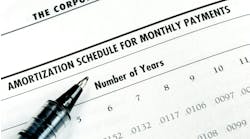Three Common Equipment Finance Myths
In the aftermath of the financial crisis, many companies put the brakes on capital expenditures to replace equipment, choosing instead to hold onto cash and squeeze as much use out of their current equipment as possible. That made sense at the time, but as the U.S. economy continues to regain its footing, some companies continue to delay replacement capital expenditures.
The negative consequences of keeping this aging equipment in operation are now beginning to mount in the form of higher maintenance costs, more downtime and less efficiency. Slowly but steadily these companies are sacrificing top-line growth since new equipment with greater production capacity could quite possibly generate more revenue. At the same time, bottom line growth is impacted by less efficient, aging equipment, which can erode margins. Ultimately, this reluctance to upgrade equipment may diminish competitiveness and long-term viability.
Equipment financing offers a way for business leaders to have the best of both worlds. It allows you to hold on to more cash than is possible with an outright purchase of new equipment, and at the same time enjoy the revenue and productivity benefits of using new equipment.
Done with the right financial partner, equipment financing can help the company grow. But before such a partnership is possible, it’s often necessary to address and debunk three common myths about equipment finance.
Myth #1: Only Certain Assets are Appropriate for Leasing.
Actually, leasing is appropriate for many types of assets and different time horizons. Logically, equipment leasing is particularly well suited for assets a company only wants to use for a relatively short amount of time, such as computers that are prone to obsolescence. By leasing these assets for two to three years, a company can regularly upgrade their computers with new lease agreements as new technologies become available.
But leasing is also appropriate for assets that a company wants to use for a longer amount of time, and even equipment it eventually intends to buy. For these longer-term assets, equipment leasing is effectively a form of lifecycle management.
Transportation (e.g., trucks) and construction (e.g., forklifts) are both examples of medium-term assets that are often leased. Companies routinely lease these types of equipment for five to eight years and then turn them back over to the lessor. The issue here is not so much technological obsolescence but simple wear and tear on the equipment and a desire to avoid costly maintenance and downtime as the equipment ages.
At the far end of the time spectrum, industrial manufacturing equipment that a company intends to use for 20 or 30 years is also suitable for leasing. These leases typically include a fixed-purchase option or early buyout option that a company can exercise in the future. This agreement gives the company all the advantages of cheaper cash flow and 100% financing at the start of the lease, coupled with the security and peace of mind that they can ultimately retain the equipment.
Myth #2: Leasing Locks me into an Agreement and Reduces my Flexibility.
In fact, leasing provides greater operational flexibility than outright ownership of an asset. In five years a lot can change in an industry, at an individual company, in the financial markets and in the overall economy. Leasing gives a company more flexibility by allowing managers to make decisions at future states and times when circumstances may have changed. At the end of the lease, the company might choose to purchase the equipment, renew the lease or return the asset to the lessor.
Another way to improve operational flexibility is through a sale-leaseback, an arrangement that allows a company that owns equipment to sell it to a financial institution and then lease it back for a specified period of time. This arrangement leverages a company’s balance sheet by monetizing existing equipment. The freed-up cash can be deployed in more strategic ways to grow the business, such as acquisitions or hiring employees.
In fact, one could argue that CFOs who don’t use all the equipment financing options available may actually reduce their operational flexibility. Relying on cash or tapping a revolver to purchase equipment can unnecessarily tie up potential growth capital in hard assets.
Myth #3: Leasing is Too Expensive.
In reality, leasing is usually less expensive than owning an asset over the long term. Leasing offers cash-flow savings on a monthly basis compared to purchase payments. And in the case of sale-leasebacks, companies can lock in today’s competitive interest rates.
Also, when buying an asset it’s critical to consider the long-term, total costs of ownership that can mount when a company holds onto an asset too long. These costs include maintenance, downtime, disposal and remarketing of the asset. By avoiding many of these costs, leasing is less expensive than ownership over the long run.
There are other, more subtle opportunity costs to factor into the lease-versus-buy equation. A lease creates better cash flow, which a company can funnel into potentially higher-yielding pursuits, such as acquisitions and research and development. By comparison, a purchase reduces cash-on-hand and has worse cash flow dynamics than a lease, which leaves less money to pursue growth initiatives.
Having cash-on-hand can be prudent in an uncertain, fast-moving business environment. But that doesn’t mean the company must forgo replacement capital expenditures. Through equipment financing, a company can have both better cash flow and better equipment. For those who have delayed equipment upgrades in the wake of the financial crisis, now may be the time to reconsider. State-of-the-art equipment that can contribute to both the top and bottom lines may be just the growth story you need.
Eric Dusch is chief commercial officer, Equipment Finance at GE Capital, Corporate Finance, specializing in providing commercial loans and equipment leases to mid-size companies for growth, acquisitions, turnarounds and balance sheet optimization.




